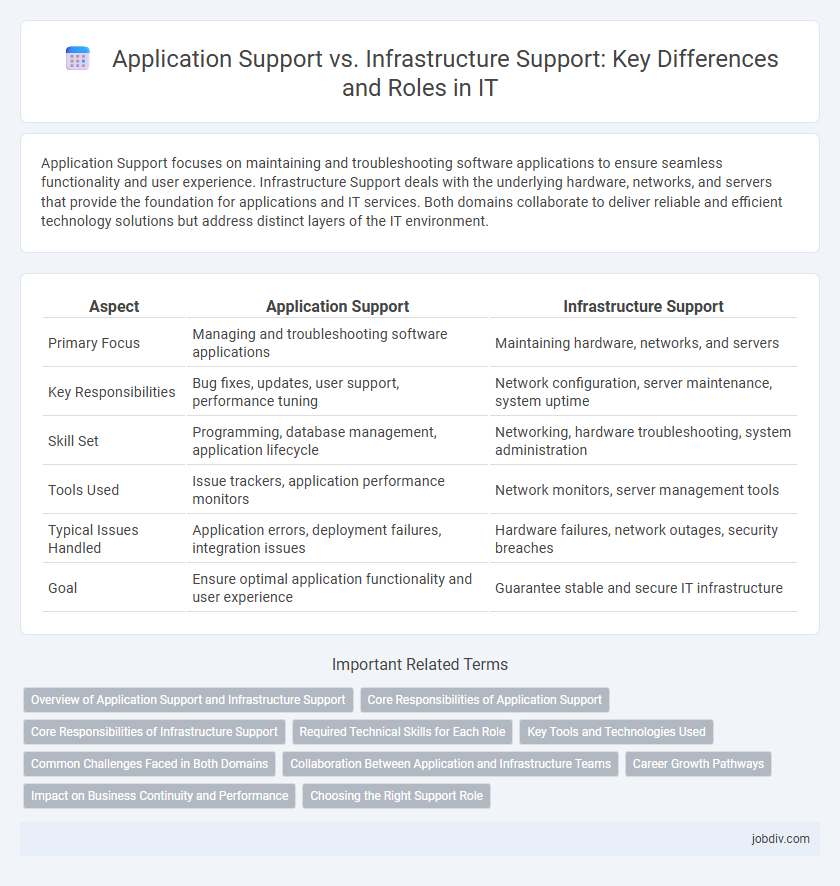Application Support focuses on maintaining and troubleshooting software applications to ensure seamless functionality and user experience. Infrastructure Support deals with the underlying hardware, networks, and servers that provide the foundation for applications and IT services. Both domains collaborate to deliver reliable and efficient technology solutions but address distinct layers of the IT environment.
Table of Comparison
| Aspect | Application Support | Infrastructure Support |
|---|---|---|
| Primary Focus | Managing and troubleshooting software applications | Maintaining hardware, networks, and servers |
| Key Responsibilities | Bug fixes, updates, user support, performance tuning | Network configuration, server maintenance, system uptime |
| Skill Set | Programming, database management, application lifecycle | Networking, hardware troubleshooting, system administration |
| Tools Used | Issue trackers, application performance monitors | Network monitors, server management tools |
| Typical Issues Handled | Application errors, deployment failures, integration issues | Hardware failures, network outages, security breaches |
| Goal | Ensure optimal application functionality and user experience | Guarantee stable and secure IT infrastructure |
Overview of Application Support and Infrastructure Support
Application Support primarily involves managing and maintaining software applications, ensuring their optimal performance, troubleshooting user issues, and implementing updates or patches. Infrastructure Support focuses on the underlying hardware, networks, servers, and data centers that enable application functionality, emphasizing system stability, hardware maintenance, and network connectivity. Both disciplines are critical for seamless IT operations, with Application Support addressing software-specific challenges and Infrastructure Support managing the physical and virtual environments.
Core Responsibilities of Application Support
Application Support primarily focuses on ensuring the smooth operation, troubleshooting, and maintenance of software applications, including issue resolution, performance monitoring, and user assistance. This role involves managing application updates, patch deployments, and collaborating with development teams to implement fixes and enhancements. Core responsibilities also encompass analyzing logs, conducting root cause analysis, and ensuring application availability and reliability to meet business requirements.
Core Responsibilities of Infrastructure Support
Infrastructure Support primarily involves managing and maintaining hardware components, network systems, and server environments to ensure optimal performance and availability. Core responsibilities include monitoring system health, performing routine backups, troubleshooting hardware failures, and implementing security patches. This role ensures that the underlying IT infrastructure remains stable, secure, and scalable to support application operations effectively.
Required Technical Skills for Each Role
Application Support requires expertise in software troubleshooting, database management, and specific programming languages such as Java, Python, or SQL to resolve application-level issues efficiently. Infrastructure Support demands proficiency in network administration, server management, virtualization technologies, and operating systems like Linux or Windows to maintain and optimize hardware and network resources. Both roles benefit from strong problem-solving abilities, but Application Support focuses more on software lifecycle and user interaction, while Infrastructure Support emphasizes hardware configuration and system stability.
Key Tools and Technologies Used
Application Support leverages tools such as application performance monitoring (APM) software like Dynatrace and New Relic, issue tracking platforms like Jira, and database management systems including Oracle and SQL Server to ensure optimal functionality and rapid incident resolution. Infrastructure Support relies on technologies such as network monitoring tools like Nagios and SolarWinds, configuration management systems like Ansible and Puppet, and virtualization platforms including VMware and Hyper-V to maintain hardware, networks, and server environments. Both domains integrate automation frameworks and cloud services such as AWS CloudWatch and Microsoft Azure Monitor for enhanced scalability and proactive troubleshooting.
Common Challenges Faced in Both Domains
Application Support and Infrastructure Support both encounter challenges such as maintaining system uptime and ensuring seamless integration between various software and hardware components. Troubleshooting complex incidents often requires cross-domain knowledge to quickly identify root causes, whether in application code or network configurations. Effective communication and collaboration between teams are critical to minimize downtime and optimize overall IT service delivery.
Collaboration Between Application and Infrastructure Teams
Effective collaboration between application support and infrastructure support teams enhances system reliability by ensuring seamless communication and rapid issue resolution. Application teams provide insights on software performance and user requirements, while infrastructure teams offer expertise on hardware, networks, and server management. Coordinated efforts lead to optimized deployment processes, reduced downtime, and improved overall service availability.
Career Growth Pathways
Application Support specialists develop expertise in software troubleshooting, user training, and incident management, opening pathways toward roles like Application Manager or Business Analyst. Infrastructure Support professionals gain skills in network administration, server maintenance, and cybersecurity, which can advance their careers to positions such as Systems Architect or IT Infrastructure Manager. Both pathways demand continuous learning and certifications like ITIL, Microsoft, or Cisco to maximize career growth opportunities in the evolving tech landscape.
Impact on Business Continuity and Performance
Application Support directly influences business continuity by ensuring software applications run smoothly, minimizing downtime and preventing disruptions in critical business processes. Infrastructure Support underpins overall IT performance by maintaining hardware, networks, and servers, which enables reliable connectivity and system availability. Both support types are essential; Application Support drives user productivity while Infrastructure Support provides the stable environment necessary for seamless operation.
Choosing the Right Support Role
Application Support specializes in resolving software-related issues, ensuring seamless functionality and user experience for business applications. Infrastructure Support focuses on maintaining and troubleshooting hardware, network, and server environments critical for overall system stability. Selecting the right support role depends on whether the primary challenges involve application performance or underlying IT infrastructure components.
Application Support vs Infrastructure Support Infographic

 jobdiv.com
jobdiv.com